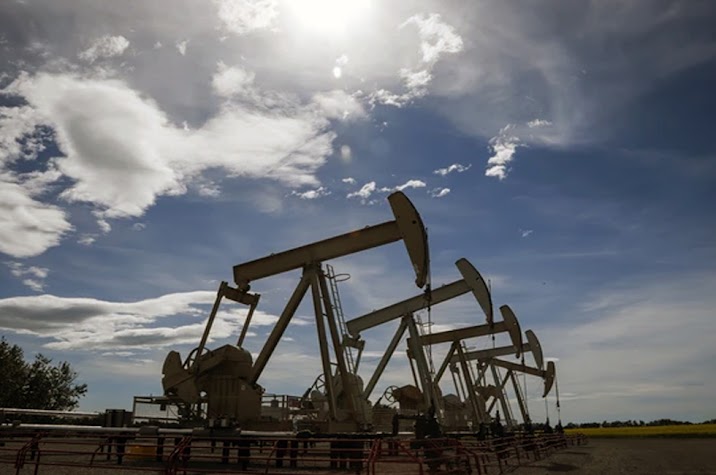 |
| Pumpjacks extract oil from the ground near Olds, Alberta. Image Credit: CANADIAN PRESS/JEFF MCINTOSH FILES. |
If the $2-trillion mission seemed daunting before Russia's invasion of Ukraine upended the global energy order, things have only gotten more complicated since then. According to Royal Bank of Canada economist Colin Guldimann, Canada must now add bolstering the energy security of Western democracies to its decarbonization mission. 'The most important piece of the puzzle is ensuring that we have an economically competitive oil sector.'
"What current events have really shown us is that oil and gas are, and will likely remain, critical components of our energy supply for the foreseeable future," Guldimann said in an interview.
"Crisis can be illuminating."
As the world looks for alternatives to Russian oil and gas, a new report from RBC's economic research department suggests that Canadian output could increase by up to 500,000 barrels per day above 2021 levels without jeopardizing Canada's climate targets. However, the report cautioned that even if Canadian barrels successfully displace those of other producers, the additional production could add 9 million tonnes of greenhouse gases to Canada's emissions each year, costing $1.5 billion to mitigate.
 |
| Image Credit: FP |
According to the Trudeau government's first comprehensive emissions reduction plan, which was released last month, Canada's oil and gas sector must reduce emissions by 42% from current levels by 2030. However, the federal climate plan was deafeningly silent on the magnitude of investment required to meet the sector's climate targets. According to RBC's report, reducing emissions from the oilsands alone will necessitate $45 to $65 billion in capital spending between 2024 and 2030.
And, given Canada's lofty climate goals, there's no time to waste.
"Over the next 24 months or so, we need a really concerted effort to lay out the foundation for where emissions cuts can come from," said Guldimann, the report's lead author. "Be it methane reductions, electrification of the oil and gas system, or laying out major emissions plans that include long-term decarbonization investments like carbon capture, on top of what the government has already said."
While the federal government's recently announced carbon capture, utilization, and storage (CCUS) tax credit is an important first step, the report found that more needs to be done to ensure widespread adoption of the technology, which is seen as a flawed but critical component of Canada's decarbonization project. According to the report, de-risking costly carbon-capture projects will necessitate more government support, ranging from a possible top-up credit from provinces to more carbon pricing certainty from the federal government.
According to the research, a large wager on CCUS has considerable drawbacks. Carbon-capture technology is costly and time-consuming to develop, so governments and industry must ensure that oilsands production remains competitive in the long run in order to justify expenditures.
Making a number of historic investments in carbon capture, which raises our cost of production, and then not having any place to sell that oil economically over the duration of those projects would be a negative conclusion for Canada, according to Guldimann.
Colin Guldimann stated that "the truly key component of the puzzle is ensuring that we have an economically competitive oil sector."
The report also lays out a path for policymakers, recommending the formation of an energy-focused stream inside the federal government's new Canada Growth Fund to speed up approvals and fund decarbonization projects. To secure market access, Canada must form new energy alliances and collaborate with friends, as well as negotiate long-term oil contracts with the US and Europe that reflect the sector's environmental efforts and geopolitical stability.
"The most essential part of the puzzle is ensuring that the oil sector is commercially competitive," Guldimann added. "There is an opportunity here for Canada, not just in terms of innovation, but also in terms of protecting the economic value of this part of the economy... let us make the most deliberate and measured judgments we can while confronting these two unique energy and climate security concerns."
However, Canada may still have a long way to go in overcoming its reputation as a high-cost, high-carbon energy source – a reputation that has contributed to the cancellation of critical energy infrastructure projects like the Keystone XL pipeline.
However, some investors believe that Canada is on the verge of correcting its image.
They refer to the Oil Sands Pathways initiative, a group of six companies that have pledged to work together to develop a CO2 pipeline connecting various oilsands plants to a storage hub near Cold Lake. According to Adam Waterous, founder of the Waterous Energy Fund, the initiative could significantly reduce the carbon intensity of Canadian oil by the end of the decade.
"We believe that towards the end of the decade, there will be significant political pressure to get Canadian barrels into the United States, not just for energy security but also to assist decarbonize the US fuel system," Waterous stated on a recent episode of the Veriten podcast, C.O.B. Tuesday.
"That's a reversal of the script," Waterous said. "That is the polar opposite of what is happening here, and it is how we see energy security and Canadian industry lowering emissions intersecting."
Nonetheless, the twin goals of reducing emissions and increasing oilsands production will be difficult to achieve.
"We only had one carbon reduction goal." "We now have goals for decarbonization and energy security," Guldimann explained. "It's difficult enough to solve one challenge... Two objectives make the journey a little more difficult. To begin with, it was an extremely difficult task."
FP









0 Comments
please do not enter any spam link in the comment box